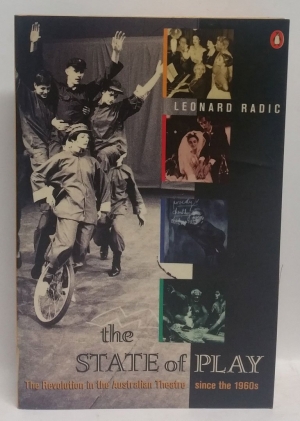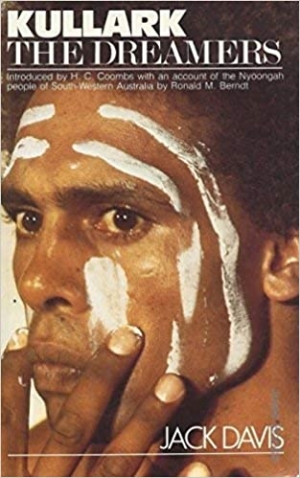Theatre
Helen Thomson reviews ‘See How It Runs: Nimrod and the New Wave’ by Julian Meyrick
It is snatching some kind of victory out of defeat, I suppose, to write a Ph.D. thesis about the rise and fall of a theatre company, and Julian Meyrick has successfully transformed thesis into book. This has been achieved mainly through very good writing; lively, intelligent and uncluttered by jargon. The formal paraphernalia of the thesis – notes, appendices, statistics, bibliography and index – are not only useful in themselves, but crucial evidence for the argument.
... (read more)John McCallum reviews 'Postcolonial Plays: An Anthology' edited by Helen Gilbert
In Neil Armfield’s recent production of Dallas Winmar’s play Aliwa – about the struggle of the Davis family in Western Australia in the 1930s to avoid becoming members of the stolen generations – the character of Aunty Dot Collard, Jack Davis’s sister, was played brilliantly by Deborah Mailman. Aunty Dot herself, flown over to Sydney’s Belvoir Street Theatre, introduced the show and then sat on the side of the stage on an old red sofa smiling benignly, and interfering occasionally, as she watched her history being performed. But which was the ‘real’ Aunty Dot was something the show left up to the audience to decide.
... (read more)Jack Hibberd reviews 'The La Mama Collection: Six plays for the 1990s' edited by Liz Jones
Playwright and professional poéte maudit, Barry Dickins launched this collection as part of La Mama’s thirtieth anniversary festivities. Dickins, it is reported, was not in a festive mood. In an unusually begrudging and self-absorbed frame of mind, he allegedly failed to extol the selected plays and went so far as to hint that one of his own tautly sprung specimens should have been included.
... (read more)Sam Sejavka reviews 'Brides of Christ, Episode 3: Ambrose' by John Alsop and Sue Smith and 'The Drought' by Tom Petsinis
As most would know, Brides of Christ was an enormously successful mini-series recently coproduced by the ABC, Channel 4/UK, and RTE/Ireland. UQP have responded to its popularity with the publication of this slim book aimed, primarily, at the education market.
Rather than inundating a potential readership with a set of six one episode volumes or, presumably, the one mega volume, the publishers have decided to provide a representative release containing the screenplay of one episode – three, Ambrose – which the writers considered to be the most likely to translate effectively onto the page. The result is a quick enjoyable read which, although unlikely to lay siege to any bestseller’s list, would certainly prove a flavoursome and challenging text for study.
... (read more)Peter Fitzpatrick reviews 'Collected Plays, Volume II' by Patrick White and 'Collected Plays, Volume II' by David Williamson
In a recent interview on ABC radio, the playwright, Stephen Sewell, deplored the lack of revivals of notable Australian plays. Now and then, one of the pioneer playwrights from the first half of the century is honoured briefly in this way, but it is much rarer to find one of the professional companies revisiting the major works of the last twenty-five years. As Sewell implied, this reflects the lack of a strong sense of a tradition of ‘modem classics’ in our theatre.
... (read more)Darryl Emmerson reviews 'The State of Play' by Leonard Radic
The subtitle of this book, ‘The Revolution in the Australian Theatre since the 1960s’, is the clue to its subject and its thesis. If it is plain that Australian theatre and, in particular, Australian drama, is now an established fact, a splendid feature of the cultural landscape, this is only a recent growth.
The author has been peculiarly placed to watch this growth, to assist it and even to inspire it. Since 1974, as theatre critic for the Melbourne Age, he has seen and reviewed more than 2000 productions, more than 1000 of them plays by Australian writers.
... (read more)Pamela Payne Heckenberg reviews 'Patrick White' by May-Brit Akerholt and 'Jack Hibberd' by Paul McGillick
Although it is accidental that these two books have been released simultaneously (they just happen to be numbers two and three in a series of monographs on Australian playwrights) it’s a fortuitous accident. In form, they provide examples of two markedly contrasting and entirely appropriate methods of dealing with the work of a playwright. And historically, both Patrick White and Jack Hibberd have been landmark playwrights. Together they may well share the honours for the instigation of the most critical vitriol in the Australian press. At the same time, their work has always generated fervent praise and support from theatre critics, practitioners, and audience members who want theatre that is surprising, challenging, and innovative.
... (read more)This dainty, delicate, savage book is lovely and rare because it is truthful, vicious, brimming with the blue eyes of memory, the red eyes of defeat, the open mouth and congo drum of childhood. When Barry Oakley writes of his childhood, it is you booting him the footy of laughter.
He writes, wonderfully, sweetly, dreamily of taking his sore-footed mum and soft-drink-eyed son for the satiric day to Taronga Zoo. Among the gorillas and orchids, you watch him scribble in the light. A journalist cobber to fellow mysteries, his friends.
... (read more)The twelve-month period which began in February 1982 saw an unprecedented growth of interest in Aboriginal drama in English, both within Australia and overseas. In that month, Jack Davis’s second play, The Dreamers, made its début in the annual Festival of Perth and was generally well received by the critics. Five months later, Robert Merritt’s 1975 play The Cake Man was revived briefly in Sydney, in preparation for its two-week season as an Australian representative at the World Theatre Festival in Denver, Colorado. So popular was it that tickets for the entire season were sold out in advance of the first performance, thereby breaking all box-office records for the festival.
... (read more)It seems that going to the theatre has always been a popular activity with Australians. Popular theatre during the period covered by this book (1834–1914) staged a remarkable variety of Australian plays: operettas, melodramas, burlesques, sensation plays, and extravaganzas. On Our Selection, the first play to be called ‘Australian through and through’, opened to an audience of more than a thousand and achieved tremendous popularity.
... (read more)









